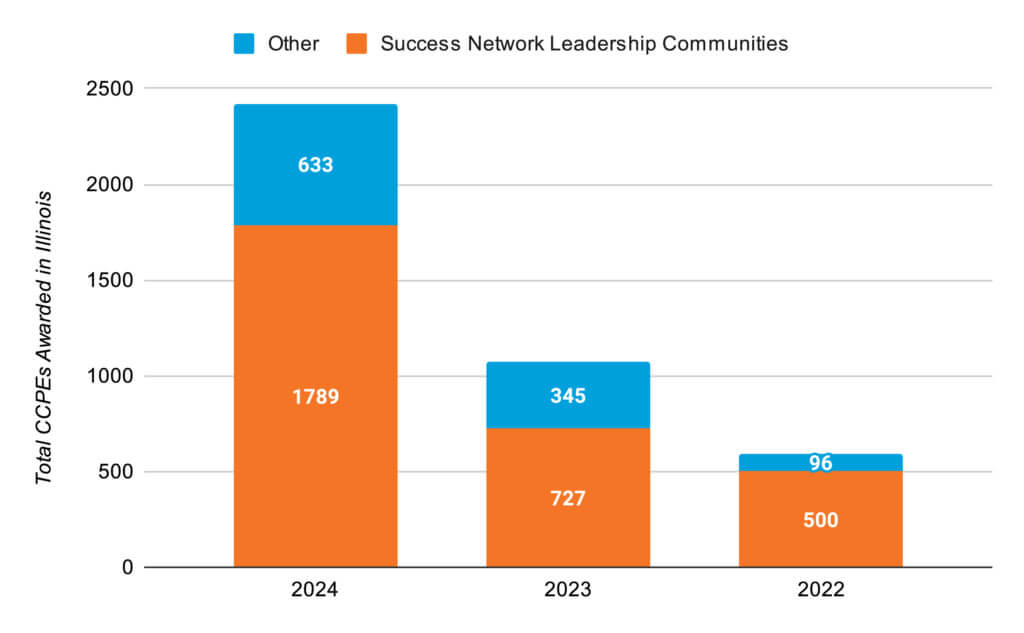Illinois has a pipeline problem: too many students still get lost in transitions as they move from high school to college and career, particularly when they are from the most marginalized communities. Despite decades of investment and collaboration, where students come from still predicts their economic future in Illinois.
Meanwhile, our education and workforce leaders are stretched thin and working in silos, without a shared vision to guide their efforts. Local initiatives show promise, but they are pockets of success rather than broader systemic transformation.
We know what good looks like because we’ve seen it work in communities across Illinois, such as our Illinois Education and Career Success Network Leadership Communities. The question isn’t whether we can create equitable pathways to economic mobility. The question is whether we can scale them statewide.
In January, we released our first-ever policy agenda to tackle this challenge head-on. Today, we’re exploring the first pillar of our agenda that makes transformation possible: Leadership, Governance, and Vision. Because when systems align around a shared purpose, students succeed.
Pillar 1: Leadership, Governance, and Vision
This blog post reflects in greater detail on the first pillar – Leadership, Governance, and Vision – which grapples with three core challenges:
- Lack of Shared Vision: Illinois lacks a shared vision to equitably drive cross-system initiatives for college and career readiness and success.
- Gaps in the P-20 Pipeline: Local and statewide leaders have inconsistently defined and prioritized roles and responsibilities in inter-organizational and transitional spaces throughout the P-20 ecosystem, resulting in a leaky pipeline for learners.
- A Stressed Workforce: Inconsistent capacity and staffing curtail the ability of community and state leaders to implement college and career readiness strategies effectively.
Building the Pipeline: Our Policy Agenda in Action
Too many Illinois students still struggle with the transitions from high school to college and career. In this blog series, explore each pillar of our policy agenda and how systemic change can create equitable pathways for every student:
Pillar 1 | Leadership, Governance, and Vision: Centering Student Success in a Chaotic Context
Pillar 2 | Creating Conditions Where Students Can Thrive
Pillar 3 | From Policy to Progress: Charting a Path to Data-Informed Continuous Improvement for Student Success
Pillar 4 | Coming soon…
Federal actions and crises continue creating uncertainty for state and local leaders, including freezing (and releasing) funds, the Supreme Court clearing the way for the US Department of Education to be dismantled, transforming higher ed financial aid and accountability priorities, and much more. State and local leaders across Illinois are both grappling with what these ever-evolving changes mean for day-to-day work, using precious time and resources to participate in lawsuits to defend Illinois’ learners and systems. Budget cuts to both education and Medicaid are leading to downstream impacts in Illinois, including higher education institutions cutting programming and school districts laying off staff.
All of these issues pull time, attention, and resources, straining an already under-resourced system. Ultimately, this chaos reinforces the importance of cohesion and alignment within states to help mitigate the impacts on an already stressed workforce and the students they work so hard to serve.
So, what needs to be true about our policies and systems in order to achieve alignment and collaboration in the service of equitable student success?
Our First Aim: Defining a North Star
Given the chaotic moment we are in, it is even more essential for statewide and local leaders in Illinois to have a shared vision for how to equitably serve learners of all ages and across the broad spectrum of the P-20 education and workforce systems. Thus, we return to our first aim:
Illinois education and workforce leaders hold a clear, shared vision for equitable economic mobility that increases learner access, retention, and success throughout the P-20 pipeline.
For the past 16 years, Illinois education and workforce leaders have been working toward a bold goal: 60% of Illinois adults holding a high-quality postsecondary degree or credential by 2025. This goal has driven extensive work by communities and institutions around the state, all working to contribute at different points in the pipeline, and was the impetus behind the Illinois Education and Career Success Network.
Now that we have largely reached this goal, it is time for a new vision that can help education and workforce leaders locally and statewide situate their work in service of a broader aim. Our idea is simple: focus on the ultimate goal of postsecondary attainment – economic mobility that can change the lives of individuals and communities across Illinois.
Focusing on economic mobility allows Illinois to align with the federal government’s increasing focus on workforce outcomes from the education sector while maintaining a values-based focus on more equitable outcomes. Further, this would bring us into alignment with the Lumina Foundation’s new Stronger Nation report, which focuses on ‘credentials of value’ and a new goal: By 2040, 75 percent of adults in the U.S. labor force will have college degrees or other credentials of value, leading to economic prosperity.
The Illinois Workforce and Education Research Collaborative (IWERC) recently published a study that highlights that, unfortunately, demography and geography still correlate with differences in long-term earnings for Illinois learners. In order to improve economic prosperity for all Illinoisans, and particularly those furthest from opportunity, our state leaders need to clearly articulate a vision and associated strategies for changing that trajectory.
There is still much work to be done to develop and socialize a new statewide goal, and we are committed to advancing it through all available channels. We are elevating this idea at policy tables that include key agency and state leaders as they consider what to prioritize in the coming year, as well as with our Success Network Policy Committee to build interest and momentum.
Our Second Aim: Coordinating the Ecosystem
To support implementation of a shared vision for student success throughout the P-20 pipeline and beyond, we turn to the leaders and organizations that make up the P-20 systems in our second aim:
A coordinated ecosystem of state and local education and workforce leaders collaborates to develop, implement, and evaluate college and career readiness policy that includes clear and consistent codification of roles and funding to support intermediary functions.
For over a decade, we have both seen and supported community and state leaders to consistently collaborate in order to effectively align their systems so that learners have more positive experiences and outcomes. This work is locally exemplified in our Success Network Leadership Communities, aligned pathways initiatives such as Accelerated Model Pathways for Information Technology (AMP-IT) and Scaling Transformative Advanced Manufacturing Pathways (STAMP), and deep community facilitation, such as our current work in Lake County. At a state level, we have supported effective interagency collaboration in ongoing transitional instruction coordination as well as more discrete engagements that have culminated in valuable resources like the Illinois Career Pathways Dictionary and the Model Partnership Agreement for dual credit. This coordination and alignment ultimately create greater clarity for leaders and learners across the state.
In the 104th General Assembly, several bills drove toward this aim. A new Dual Credit Quality Act amendment (Public Act 104-0012) creates a standing committee composed of secondary and postsecondary representatives that will meet at least annually to “focus on approving accessibility, quality, and alignment of dual credit programs to meet the needs of students.” This committee is a key strategy to promote greater alignment of our secondary and postsecondary systems to create clarity for leaders and access for students. Given that it will also undertake potential updates to the Model Partnership Agreement, this may help foster effective collaboration and negotiation in communities statewide. We are working with our agency partners to identify key issues this committee should undertake, support their learning, and shape the rules that come out of this new law.
Another example from the 104th GA is SB58, which amends the Department of Commerce and Economic Opportunity Law to create a technical assistance program for emerging regional manufacturing partnerships connecting employers with secondary and postsecondary students. Regional partnerships, such as those in our STAMP initiative, which inspired this legislation, promote collaboration and systems alignment that result in greater student access to quality pathway opportunities. We also see how intentional, structured, and strategic collaboration through our Success Network Leadership Communities results in meaningful increases in student access and outcomes. The chart below illustrates how the plurality of College and Career Pathway Endorsement earners come from Success Network Leadership Communities.

Beyond these effective local collaborations, we hope to see more work at a state level to prioritize, model, and clarify alignment opportunities that will ultimately result in a less leaky pipeline of learners. This may happen through future legislative action, but we also believe our state agency partners can drive this through rulemaking and guidance (such as for the amended Dual Credit Quality Act) as well, and will work to advance clear and consistent alignment systemically.
What’s Next?
In the coming months, we will reflect on each of our remaining policy agenda pillars to share related policy developments and highlight emerging ideas about how to achieve the aims we are driving towards.


